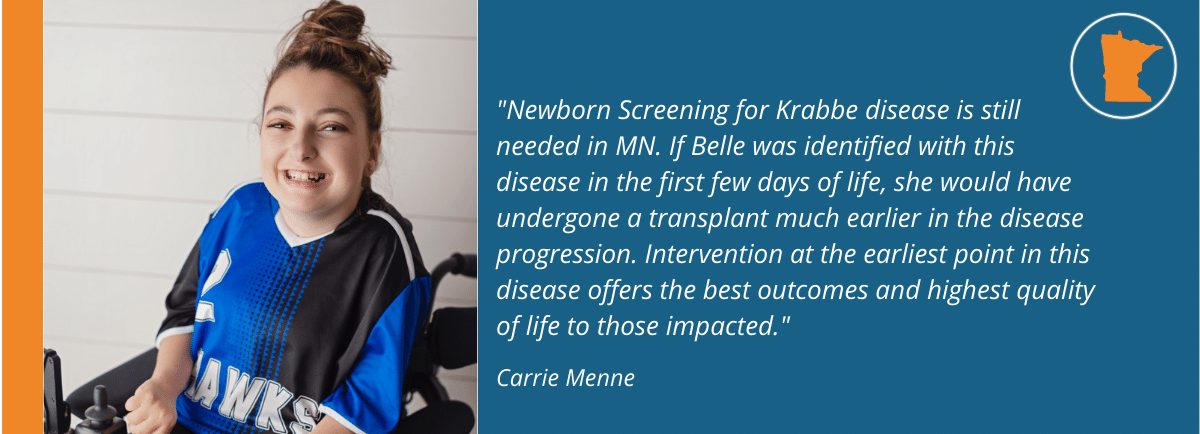DOWNLOAD STATE FACT SHEET AS PDF

In 2020, there were 63,443 live births in Minnesota2 There are 61 conditions on the Minnesota Newborn Screening Panel 3
All babies in the United States are screened for several conditions shortly after birth. Approximately 24-48 hours after a baby is born in the United States, the heel is pricked by a nurse to collect a small sample of blood. Afterward, the nurse puts a series of blood drops onto a filter paper to create several “dried blood spots.” Next, the newborn screening card is sent to the state laboratory for analysis. MN does not currently screen for Krabbe disease however, recent efforts are underway by The Legacy of Angels Foundation. The MN NBS committee will vote in October/November 2022 on whether to add the condition to their state’s screening panel.
What is Krabbe Disease?
Krabbe disease (pronounced krab A) is a rare genetic disorder known as globoid cell leukodystrophy. In the United States, Krabbe disease has been reported to affect approximately 1 in 100,000 individuals. 1 Infantile Krabbe disease is the most common and severe form causing infants to lose the ability to eat, extreme irritability, inability to sit up, and grasp objects, blindness, and seizures. Sadly, infants die within the first 2-3 years of life in states that do not test for Krabbe disease. We invite you to learn more about Understanding Krabbe Disease.
Why Screen for Krabbe Disease?
Krabbe disease is a severe neurodegenerative and rapidly progressing condition requiring immediate treatment for the most severe forms. Belle was diagnosed with a later onset form of Krabbe disease allowing her family additional time to navigate treatment. However, the medical issues and symptoms of any form of Krabbe disease are significant and life-impacting. A delayed diagnosis, especially in the most severe forms, equates to palliative and supportive care as the only means of treatment until premature death. Download Minnesota Fact Sheet
Krabbe Disease Hero: Belle Menne

See all our Krabbe Disease Heroes.
Carrie and Eric Menne were thrilled to welcome their daughter, Isabelle, into their lives. As she grew and developed they began to notice that she was losing milestones and began to seek answers. Finally, at fifteen months, Belle was diagnosed with Krabbe Disease. The neurologist that gave the diagnosis didn’t know much about Krabbe Disease; he told them that Krabbe would take Belle’s life by age three and that they should go home and enjoy the time they had left with her. Thankfully, Carrie and Eric brought up the possibility of a transplant – because of their research and diligence, Belle was transplanted successfully.
Today, Belle is an amazing, smart, funny, and caring young adult. She loves math and was on the dean’s list at college last year. She is a season ticket holder for the MNUFC soccer team. Belle loves the sun and being at the cabin.
Resources
- The Leukodystrophy Newborn Screening Action Network is dedicated to advancing newborn screening for leukodystrophies and lysosomal storage disorders, supporting newly-diagnosed families, and ensuring collaboration between all stakeholders. Learn more at https://ldnbs.org/.
- CDC offers funding and assistance through the Newborn Screening Quality Assurance Program (NSQAP). More information can be found at https://www.cdc.gov/labstandards/nsqap.html.
- Baby’s First Test provides funding opportunities through grants. Learn more at https://www.babysfirsttest.org/newborn-screening/funding-opportunities.
- American Public Health Laboratories NewSTEPS program provides data, technical assistance, and training. Details at https://www.newsteps.org/.
- KrabbeConnect offers patient support services to help families navigate the burden of Krabbe disease. Learn more at https://krabbeconnect.org/.
- Hunter’s Hope Foundation is a non-profit organization committed to giving hope through education, awareness, research, and family care for all leukodystrophies. Learn more at https://www.huntershope.org/.
Citations
- Wenger DA. Krabbe Disease. 2000 Jun 19 [Updated 2011 Mar 31]. In: Pagon RA, Adam MP, Ardinger
HH, et al., editors. GeneReviews® [Internet]. Seattle (WA): University of Washington, Seattle; 1993-2017. - “Fertility Rate: Minnesota, 2010-2020.” March of Dimes | PeriStats, https://www.marchofdimes.org/peristats/data?reg=99&top=2&stop=1&lev=1&slev=4&obj=1&sreg=27&creg. Accessed 6 Sep. 2022.
- “Minnesota | Baby’s First Test | Newborn Screening | Baby Health.” Babysfirsttest.org, 2015, https://www.babysfirsttest.org/newborn-screening/states/minnesota. Accessed 6 Sept. 2022.
All information in this fact sheet is based on data available before September 9, 2022.


